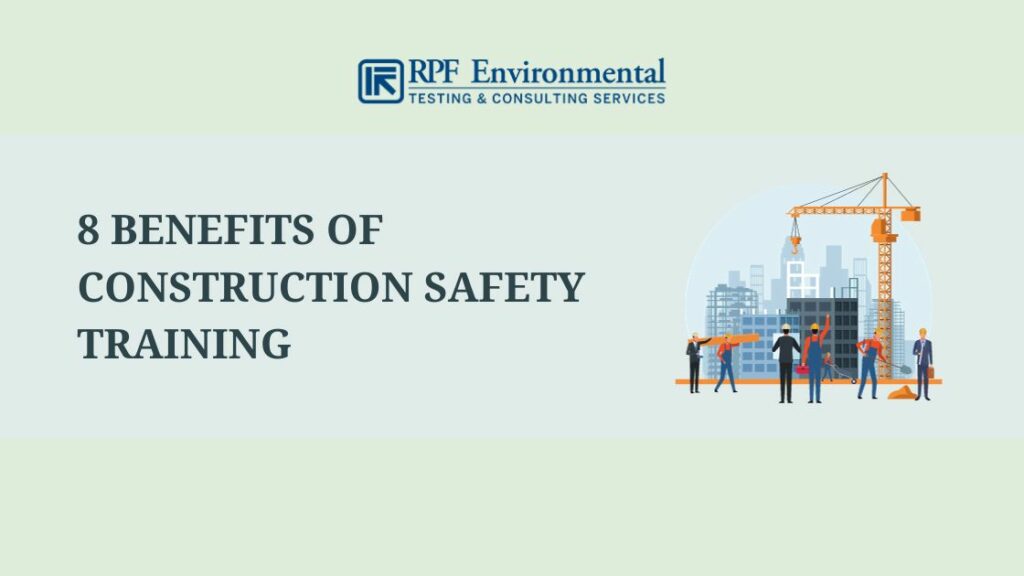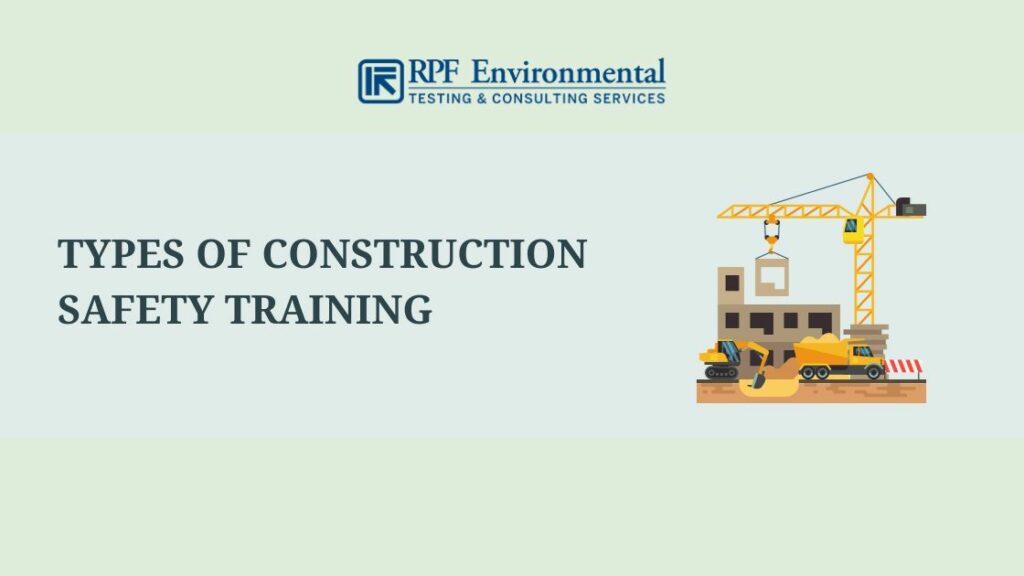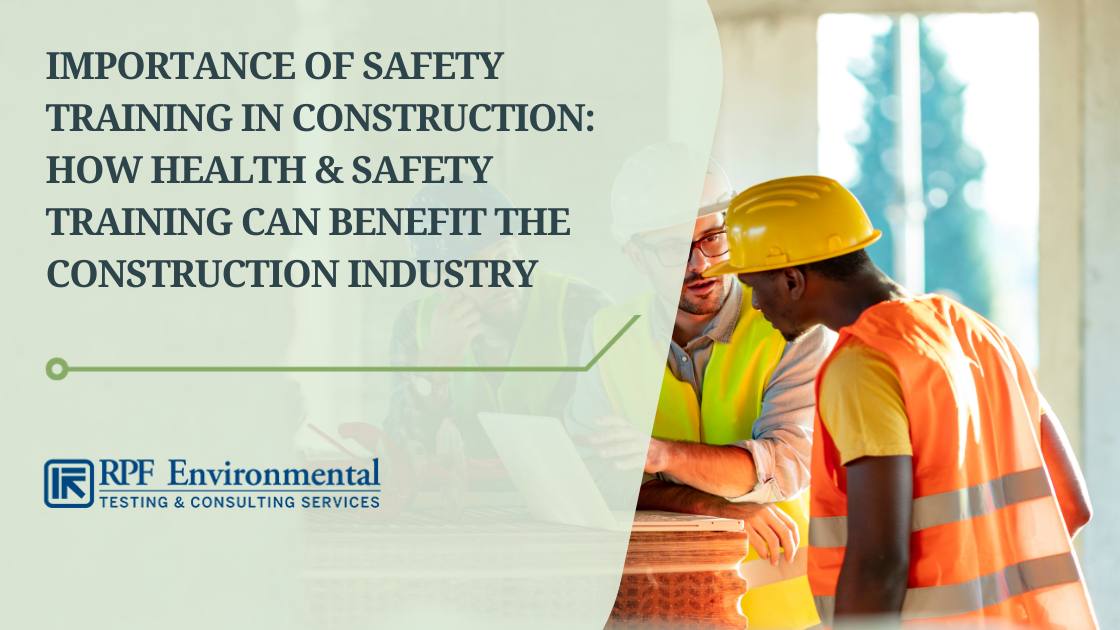Health and safety training in construction significantly reduces accidents and fatalities as well as boosts productivity, prevents lawsuits and liabilities, cuts unnecessary costs, and ensures your company’s success.
There are numerous hazards that heavy equipment operators and other construction workers are exposed to every day. This makes health and safety training crucial in the construction industry to reduce accidents, injuries, and fatalities aside from regulatory compliance.

RPF Environmental offers various health and safety training programs including OSHA construction safety, HAZWOPER, Lockout/Tagout, confined space entry, PPE, and more. We also offer OSHA compliance consulting services at the best prices. Contact us now!
8 Benefits of Construction Safety Training

#1. Reduce or Eliminate Hazards to Prevent Accidents & Fatalities
OSHA’s fatal four construction hazards include falls, electrocution, struck-by incidents, and caught-in or between hazards. Through construction safety training, employees will be well-informed on various workplace hazards which will keep them prepared for avoiding injuries while working.
They will be equipped with the right skills and knowledge to:
- Safely perform their tasks without creating additional hazards that could endanger themselves or others
- Identify, assess, and control hazards effectively
- Choose the right personal protective equipment, how to properly use it, and when to use it
- Respond to emergency situations including first aid procedures
In addition, employees and supervisors will understand their roles and responsibilities better to help prevent accidents before they occur.
Also Read: Effective PPE Selection & Hazard Assessment: 6 Factors to Consider When Choosing Workplace-Specific PPE
#2. Promote Public Safety
Since construction sites are often located in high-traffic areas, promoting public safety is another priority. Heavy equipment operators can endanger innocent bystanders and pedestrians aside from their fellow construction workers.
Also Read: 12 Heavy Construction Equipment Safety Tips & Important Safety Precautions to Prevent Workplace Hazards
#3. For Regulatory Compliance
OSHA requires employers to create a safe and healthy workplace for their employees which includes providing adequate safety and health training.
Construction Safety Training Should Be Conducted Regularly
Training programs should be comprehensive and conducted regularly to keep workers updated. New and old employees should be trained continuously to keep their knowledge fresh and skills sharp. Keeping them updated on the latest industry trends, best practices, and new hazards will not only ensure their safety but also help them achieve their full potential which can greatly benefit your business.
Develop a Written Safety & Health Program to Better Protect Your Employees
Among the most effective ways to protect construction employees is establishing and implementing a safety and health program to avoid project disruptions caused by worker injuries or illnesses. These programs aim to proactively identify and address construction site hazards to prevent future accidents.
#4. Protect Your Business From Expensive Legal Issues
Noncompliance with federal and state construction regulations caused by failure to provide comprehensive OSHA construction training can lead to costly fines, penalties, lawsuits, and violations.
Top 10 Most Frequently Violated OSHA Standards in the Construction Industry
According to OSHA, below are the top 10 most frequently cited OSHA standards in the construction industry:
- 29 CFR 1926.501 (Fall Protection)
- 29 CFR 1910.1200 (Hazard Communication)
- 29 CFR 1926.1053 (Ladders)
- 29 CFR 1910.134 (Respiratory Protection)
- 29 CFR 1926.451 (Scaffolding)
- 29 CFR 1910.147 (Control of Hazardous Energy or Lockout/Tagout)
- 29 CFR 1910.178 (Powered Industrial Trucks)
- 29 CFR 1926.503 (Fall Protection Training)
- 29 CFR 1926.102 (Eye and Face Protection)
- 29 CFR 1910.212 (Machinery and Machine Guarding)
#5. Boost Productivity, Improve Employee Morale, & Enhance Workplace Communication
Accidents, illnesses, and injuries can cause project delays and affect productivity. With adequate construction worker training, the likelihood of these incidents can be lowered which, in turn, reduces employee absenteeism and improves productivity levels.
In addition, trained employees will feel more secure and confident in executing their assigned tasks. Training will encourage them to work harder and safer as well as be more responsible which can increase productivity further. Lastly, workers who are properly trained will understand each other better and will be able to develop and quickly implement action plans to maintain workplace safety.
#6. Cut Unnecessary Costs
Accidents, injuries, and even deaths can cause expensive direct and indirect costs including the following:
- Worker compensations
- Medical bills
- Equipment and/or property damage
- Lawsuits, fines, and penalties
- Hiring new workers
- Project delays and disruptions
- Reputational damage
Safety training will promote safe work practices to avoid unnecessary costs caused by construction incidents.
#7. Create Accurate Documentations
Construction safety training does not only focus on preventing hazards. It also includes proper and accurate documentation in case of accidents which is another requirement by OSHA. Thus, helping you stay compliant aside from identifying gaps that need to be improved in your safety program.
#8 Ensure Your Company’s Success
Having trained workers is crucial to the survival and success of your company. They play a major role in protecting your company’s reputation by preventing negative incidents that could tarnish your company’s image.
Types of Construction Safety Training

The type of construction training that employees should receive will depend on their job duties, the type of equipment they will use, workplace conditions, types of hazards, and others. Training includes basic construction safety training and other specialized training programs.
Among the topics and types of training for construction workers include the following:
- Basic safety awareness
- Hazard and risk identification
- Understanding their roles and responsibilities
- Hand Signaling
- Fire safety training
- Emergency response training
- Personal Protective Equipment (PPE) Training
- OSHA construction training
- Excavation & Trenching
- Power Tools Handling Training
- Crane hazards management
- Basic rigging safety training
- Fall protection & Prevention training
- Welding Safety Training
- Hazard communication
- Harnessing training
Conclusion
Construction health and safety training keeps workers and supervisors informed about job site hazards and necessary controls to promote workplace safety. This, in turn, avoids accidents, boosts productivity, prevents financial losses, and ensures your company’s success by maintaining a good reputation.
RPF Environmental has certified professionals offering different types of construction health and safety training in Maine, Massachusetts, New Hampshire, and beyond New England. We also offer Phase 1 and Phase 2 Environmental Site Assessments. Book a consultation now!




